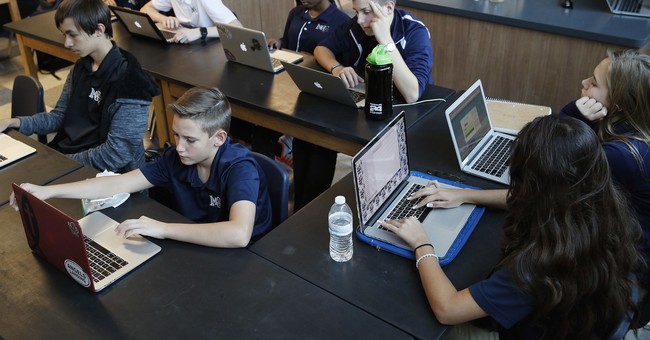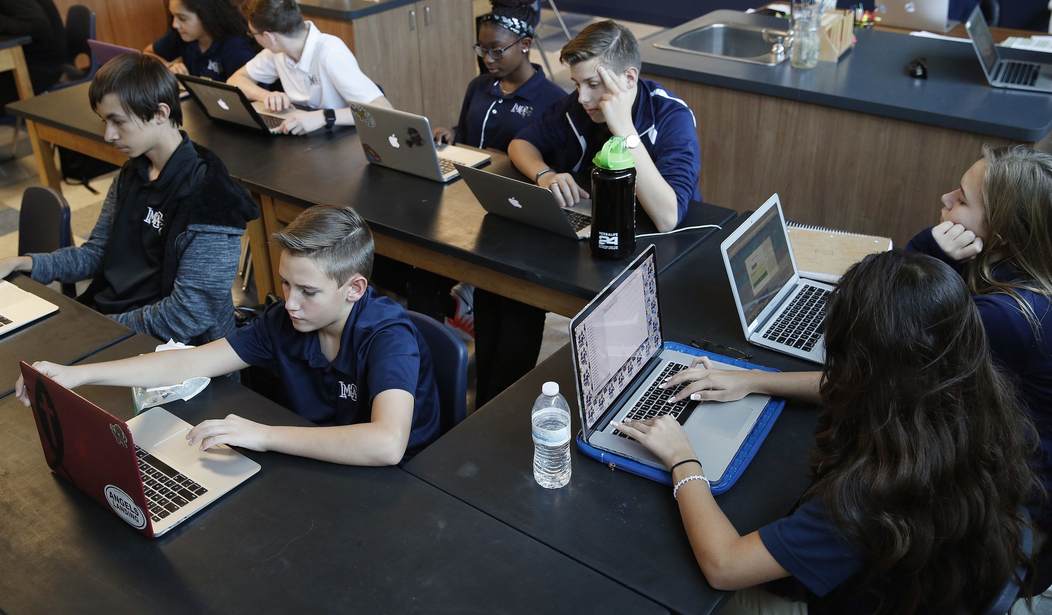
In this Nov. 16, 2017, photo, students work on computers in a freshman biology class at Lake Mead Christian Academy in Henderson, Nev. Standardized tests are a given in public schools, and they’re mandatory for Nevada private schools participating in the state’s budding school-choice program. Schools in Nevada’s voucher-like program for low-income families are required to begin submitting test results next year and Nevada is trying figuring out what to do with that information (AP Photo/John Locher)
Now that we’re in the second month of distance learning/district-mandated homeschooling, we’re seeing a lot of flaws in the system. School systems are struggling to make it possible for distance learning to happen, and there are a lot of reasons why it can’t happen with any sort of fidelity.
Families who live near or below the poverty level can’t always afford a home computer and/or Internet access, especially if they’ve been let go because businesses can’t operate in this environment. Likewise, teachers who aren’t paid exceptionally well at times, are also struggling because they have to revamp their lesson plans, adapt them for online learning, and do many extra things in order to ensure that they are giving their kids everything they can to help cover the material they didn’t get to.
School districts are bloated with administrative costs at the expense of resources desperately needed to operate classrooms regularly, much less through forced online learning. There might be money in wealthier districts to rent out working laptops and Internet hotspots to students who need them, but districts in impoverished areas don’t have the resources to provide all students with equal access to technology in their own classrooms.
Jim Geraghty points out at National Review that schools weren’t prepared for this and that this experiment is going to provide generally poor results.
The 2019-2020 school year, from about mid March on, will have to be written off as a forced experiment with middling results at best. Most school districts are concluding they can’t fairly grade students in these circumstances, because kids are getting wildly different education experiences, dependent in part on whether they can get a strong wireless signal. Some kids will have good home-learning environments. Some kids will have really challenging home-learning environments. And some kids will have their father intermittently asking, “Hey, you’re doing whatever that stuff is that you’re supposed to be doing, right?” in between writing Corner posts.
Bethany Mandel, a parent who has homeschooled and worked on homeschooling curricula, makes a valid point at The Atlantic: School systems need to work more on providing tools to allow parents to be able to help their children, not alienate them from each other.
The situation into which almost every parent in America has now suddenly and unwillingly been thrust could not be more different. One-size-fits-all education barely works in a classroom, but it is completely unmanageable with kids spread out across their various households working independently.
Most kids aren’t going back to school this calendar year; school districts have already conceded as much, as have many universities. Parents are in this not just for a few weeks, but for a few months.
And is this how families want to be spending the next months? Sitting inside staring at a computer screen for six hours a day? Most adults have a hard time in online meetings for that long for one day; it’s completely unreasonable to expect it of a child for months on end. And it’s leading to behavior issues, too. On one recent Facebook thread about screen time–generated outbursts, one mother wrote, “This is a major conflict in our family because we do not believe in this amount of screen time, and the kids thrive without it. Yet it is expected in order for online learning to occur.”
One of the biggest criticisms of the Common Core State Standards (CCSS) is that they encourage the idea that only schools can help students. That’s not entirely true, as standards don’t dictate curriculum or how something is taught (rather, they provide the framework for the skills your child needs). But, the curricula that get written around the CCSS are written by people who are inherently anti-school choice. They write material that can only be translated by teachers who have undergone pedagogical training and that isn’t something you can’t really explain to students or their parents during a parent-teacher conference. What’s more, there are many teachers across the country who were never properly trained to implement standards in their classrooms.
But the struggles at home have not stopped the anti-school choice advocates from using this opportunity. They point to the failures of distance learning as proof that parents and private entities can’t do this and that public education is the only way this happens.
Harvard law professor Elizabeth Bartholet wrote an article recently calling for a ban of homeschooling. Other activists have made similar calls, especially with all our students at home and learning on their own with whatever help parents can give. Bartholet’s primary concern seems to be that Christian conservatives are at home, teaching their kids. Nevermind that religious-based homeschooling only accounts for about two-thirds of homeschooled families and not all of them are conservative Christians.
Unfortunately, people do not want to let a crisis go to waste. What we are seeing now more than ever is that school choice is incredibly necessary. If your school or district cannot provide for your student the resources they need to be successful, you should be allowed to find another school. If your district does not prioritize resources for the classrooms instead of for administrators in district offices who aren’t held accountable by student results, then find a different district.
What we should be seeing, then, is more options for choice. I hope that parents are paying attention and that the public school systems of America are paying attention. You know who isn’t struggling to get resources to students? Parochial schools. Private schools. Charter schools. Schools that prioritize the resources their students need. That’s who is most successful at this transition right now. The situation is not ideal for anyone, mind you, but they are making the best use of it.
Find a way to fix the system, because this chaotic crisis is pointing a gigantic spotlight on all of its flaws. Public schools aren’t the solution here. The system that props up public schools is the problem.












Join the conversation as a VIP Member